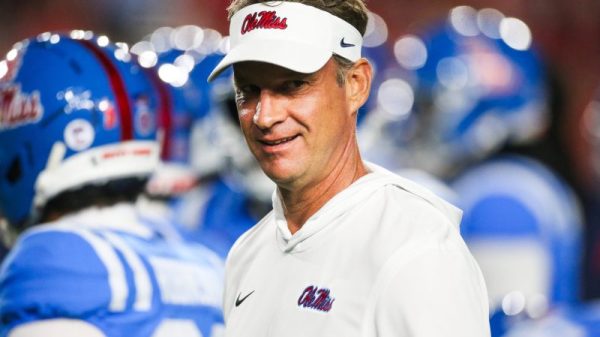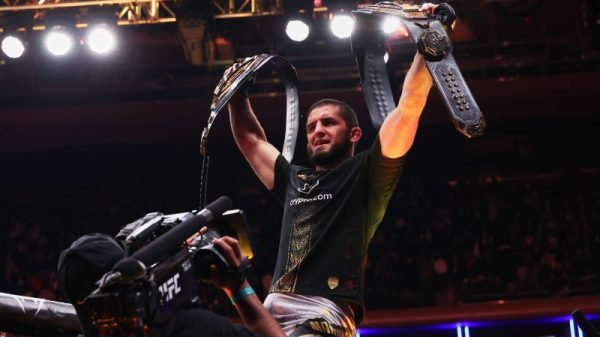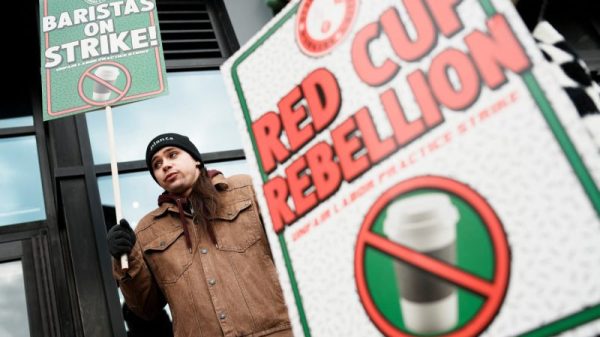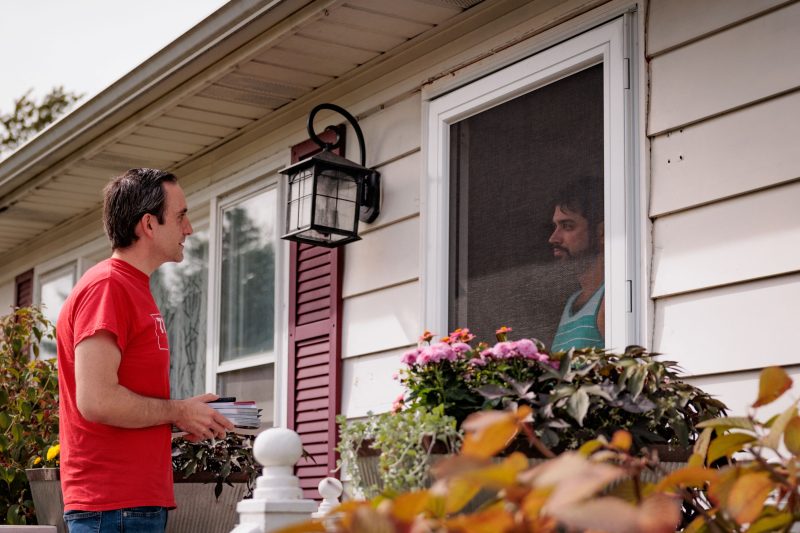The world’s richest man, Elon Musk, has offered Americans $47 for each swing state voter they recruit to his effort to elect Donald Trump.
Democratic groups have started paying at least $160 to more than 75,000 voters who agree to contact dozens of their friends and relatives with requests to support Kamala Harris.
In Philadelphia, a nonprofit plans to mail 102,000 copies of a comic book this weekend to every voter under the age of 32, featuring the Liberty Knights, a superhero squad that defeats Dr. Mayhem’s quest to steal the city’s spirit, entomb it in ruby shards and stop the youth from voting.
For those who would still rather party than do politics, there are free concerts, street festivals, coat drives, tailgates and daytime raves popping up near early voting centers in key states that blur the difference. Other operations are hiring thousands of people and organizing many more volunteers to knock on doors, place phone calls and share social media about how to vote.
None of these get-out-the-vote efforts are the work of the presidential campaigns or political parties. They belong instead to a vast, shadow machinery built by partisans often under nonpartisan banners to provide the final nudge that delivers the White House by mobilizing unlikely voters in about seven states. Funded largely without public disclosure, through local outfits and national networks, most of the operations have been lying in wait for years in preparation for this moment.
“We are registering tens of thousands of voters, signing up tens of thousands to vote by mail, and we are maximizing early vote,” said Kevin Mack, whose tax-deductible nonprofit, the Voter Project, created the comic book and has tried to juice voting by giving away $1,000 Target gift cards, $2,000 rent checks and $10,000 grants to community groups around the Democratic-heavy neighborhoods of Philadelphia. “At the end of the day, the combined efforts will increase youth turnout in Pennsylvania by over 100,000 people.”
There is no centralized way to know how much money they will spend or just how many people they will reach. Many of the national groups refuse to disclose their budgets, while hundreds of local groups fly entirely under the national radar, funded through tax classifications that will not report their income until next year and will never disclose their donors.
But people involved expect independent field and mobilization machines to easily be measured in the hundreds of millions of dollars. Given the razor thin margins dividing Trump and Harris in the target states, they could easily prove decisive in one or more states.
“Groups like ours grew over time to become these behemoths because we could do this cheaper and more efficiently than a campaign,” said Ralph Reed, the chairman of the Faith and Freedom Coalition, which he says has deployed about 4,000 part-time paid staff and many more volunteers in the battlegrounds with the goal of knocking 10 million doors, including repeat visits. “A presidential campaign stands up in 12 to 15 months, and building this takes much longer than that to do right.”
On the left, a long-standing national network, America Votes, has a goal of knocking on doors in the seven states more than 30 million times this year. Organizers say their focus is on about 2.5 million suspected Democratic-leaning voters who started voting in federal elections after Trump’s 2016 victory. The field operation is done in partnership with dozens of other groups — including BlackPAC, Somos PAC and the Unite Here union — and includes tens of millions of dollars transferred from Future Forward, the largest independent advertising operation supporting Harris.
One of their partners, the Campaign for a Family Friendly Economy, which is focused on supporting Harris and expanding the federal social safety net, is budgeted at $40 million with a focus on eight states, including four of the core presidential battlegrounds, according to a briefing document obtained by The Washington Post. They claim to have already deployed more than 4,200 paid canvassers to knock on more than 3 million doors and make contact with more than 150,000 voters.
“With Trump on the ballot, we assume there will be another huge turnout from Trump’s base. Winning these battleground states means a Blue Surge matching the MAGA Surge’s turnout,” said Greg Speed, America Votes’ president, in a statement. “In a numbers game, there are more of us than them, but mobilizing our young and diverse coalition requires a massive mobilization not only online, but especially on the doors to break through the noise and get out the vote.”
That numbers game has become an obsession in the closing weeks of the campaign, as more money is pushed into a smaller battlefield than any recent presidential contest, largely because Florida, Minnesota, New Hampshire and Nebraska’s 2nd Congressional District have become less competitive. All told, the seven primary states in play — Wisconsin, Michigan, Pennsylvania, Nevada, Arizona, Georgia and North Carolina — cast 31 million votes in 2020, or 20 percent of the ballots nationwide.
But the share of voters still undecided in those places — not knowing whether to vote or whom to vote for — is just a fraction of that group, dominated by people who are disconnected from mainstream political conversations. The least attentive now find themselves the targets of an avalanche of political spending, invading their phones, infiltrating their friend networks, knocking on their doors and showing up in advertising where they consume media.
“We are talking about maybe 5 million human beings out of 42 million who are registered in seven battleground states,” said Dmitri Melhorn, a Democratic strategist at Oakland Corps who has worked to develop the outside infrastructure on the left. “You are talking about one out of eight or one out of nine people. You are talking about people who are different in how they consume politics.”
No single independent group compares to the size of the two major-party campaigns and their affiliated national and state parties, which have all begun to ramp up operations.
The coordinated Harris campaign boasts 2,500 staff and 353 offices in the seven targeted states, while the smaller Trump operation claims more than 300 offices for “hundreds of staff.” Both have been deploying small armies of weekend volunteers — the Harris campaign said it knocked on 800,000 doors and made more than 10 million calls last weekend — though the campaigns have been selective in the numbers they release. The Trump campaign has an elaborate system for rewarding about 40,000 trained “super volunteers,” who can earn a special hat, apparel and other memorabilia if they hit certain benchmarks of voter contact.
But neither campaign has designed their program to work in isolation. Both are counting on their independent allies to fill in gaps and multiply their efforts.
“It is very much the field goal unit, and here we are in the fourth quarter,” said Donald P. Green, a political scientist who studies voting behavior at Columbia University. “Polls tend to report likely voters. Turnout efforts tend to target unlikely voters, and of course a few percentage points could turn any of the seven contested states.”
Harris campaign chair Jen O’Malley Dillon released a list of voter mobilization organizations in September that she said “will play a critical role” in the campaign’s success, in a clear signal to donors interested in writing unlimited checks. They included America Votes, SOMOS, BlackPAC and Galvanize, a group that targets White women.
Another group on O’Malley Dillon’s list, the Strategic Victory Fund, is funding a program called ProgressNow that has announced $60 million in spending across 10 states, including the seven battlegrounds, with the goal of creating “a surround sound environment” for targeted voters through digital ads, organic viral posts and other social media, said Anna Scholl, ProgressNow’s president.
The group has 90 paid organizers and more than 20,000 volunteers creating and sharing content. Some of the most successful pieces of content, including messaging about getting to the polls, have involved digital ads meant to look like horoscope readings or viral ASMR, a whispered type of video meant to give listeners tingling feelings.
“It’s one of those things that you look at and say I don’t know entirely why that works, but it does,” said Scholl.
Two other Democratic-leaning efforts, Relentless and the Empower Project, have been recruiting tens of thousands of lower propensity voters in Democratic-leaning communities across the battlegrounds to work as paid relational organizers. For a few hours’ work, more than 75,000 people will make real money calling, texting, emailing or posting in the social feeds of their friends and family with messages to support Harris and urge people to get to the polls.
“You can see 100 TV ads about how great a movie is, but if your best friend tells you it’s horrible, you believe them. We believe the same thing is true in politics,” said Mike Pfohl, Empower Project’s president, who expects to hire more than 40,000 “mobilizers” to reach 10 million voters across 10 states, including the seven battlegrounds, through the effort.
Relentless is active in five of the presidential battlegrounds states with a target of 35,000 paid communicators. They offer $160 for a few hours’ work, and then $40 more if they do more texting and calling on Election Day, when data will be updated to make clear who has still not voted.
“What we look for in a participant is someone who is a low-turnout voter but interested in getting involved this year,” said Davis Leonard, the chief executive officer of Relentless, an effort funded by the Progressive Turnout Project. “Their sphere of influence is bigger than they think.”
The Trump campaign has boasted about its recent partnerships with multiple outside efforts, including relative newcomers to the field organizing space: Turning Point USA and Musk’s America PAC, a group that has been sending canvassers, mail and text messages into swing states, spending more than $87 million in recent months. (Musk has donated nearly $75 million to the group through late September, about 90 percent of the money raised, according to federal filings.) Both groups have struggled in recent weeks as they have tried to rapidly scale up their operations, with Turning Point recently merging its operations in Wisconsin with America PAC.
Outside groups on the right have also so far dominated the postal get-out-the-vote or early-vote efforts, according to the tracking firm Mintt. Two-thirds of such mail has come from outside groups, and eight of the top 10 organizations sending mail with those messages are Republican, including America PAC, the National Sports Shooting Foundation, a gun manufacturer trade group, and Women Speak Out Fund, an affiliate of SBA Pro-Life America.
Women Speak Out has announced plans to reach 10 million persuadable and low-turnout voters in the 2024 cycle. The National Sports Shooting Foundation effort, which is focused on driving registration and turnout among gun owners, does not endorse any candidate but has tried to highlight the contrast in the presidential contest between Trump and Harris, said Mark Oliva, a spokesman for the group. “We think she has made her position on gun rights pretty clear,” he said.
Groups that benefit Democrats, meanwhile, have been dominating another category of outside spending: free giveaways and party promotion to make voting feel fun.
The Detroit Pistons in partnership with Rock the Vote, a nonpartisan nonprofit that holds events largely in Democratic areas, will hold a downtown Detroit “tip off early voting” event on Saturday called “Pistonsland,” with carnival rides, food and performances by hip-hop artists Lil Baby, Baby Face Ray, Peezy, Sada Baby and Skilla Baby. Other “Vote City” events have been planned for Philadelphia and Milwaukee. Rock the Vote has also partnered with the WNBA and the NFL on voter education and mobilization efforts.
“Teaming up with musicians and sports teams for these on-the-ground activations enable us to reduce barriers and create opportunities to participate,” said Carolyn Dewitt, Rock the Vote’s president, in a statement.
Daybreaker, a daytime party promoter championed by Democratic donor advisers, has a packed schedule of officially nonpartisan midday dance parties planned for cities across the battleground map over the coming weeks to promote voting and registration. One Detroit event in New Center Park is promoted as featuring both “pole dancers” and “poll dancers” — and free breakfast.
“We’re bringing the collective joy back to collective action — So dress in purple — and let’s party to the polls!” announce the promotions for the events, which include stops in places like Las Vegas; Flagstaff and Phoenix in Arizona; Ann Arbor, Mich.; and Kenosha and Green Bay in Wisconsin.
In major cities, the Harris campaign has begun paying for weekend street festivals near early-voting centers, but their effort joins other groups that have already been in the communities for a while. One group called ShowUpStrong24 has been holding neighborhood events for months around voter registration in Philadelphia, a program that is now shifting to early-vote activation.
Christian Leonzo Vargas, a marketing consultant who has been leading many of the efforts, has organized coat giveaways, rent check giveaways, free “brews and ballots” events at a local brewery and backpack giveaways in recent months. This week he will hold a silent journaling event in one neighborhood, followed by a walk to an early-voting place with headphones that allow everyone who gathers to listen to the same songs.
One recent sweepstakes organized on social media gave away two $1,000 Target shopping sprees. Participants had to check their voting registration online, resulting in more than 1,000 new voting registrations, Vargas said. He said the offer of help for people struggling makes the conversation about voting easier.
“We went into low-propensity neighborhoods at their low-propensity apartment complexes,” Vargas said about the back-to-school giveaway that distributed 1,500 backpacks. “One of the things the community members said was, ‘Thank you for helping us before asking for something.’”
StandUpStrong24 and the Voter Project are fully tax-deductible, nonpartisan nonprofits that do not expressly show support for any party or candidate. Like dozens of other similar groups that could impact the result next month, they will never have to disclose either their donors or how much they spent on all the free stuff they gave away.
Other efforts are far more conventional. On an early Thursday in Detroit, at a job site at the Gordie Howe bridge, volunteers for the AFL-CIO union members handed out fliers on one side explaining Harris’s role in casting the tiebreaking vote for the American Rescue Plan, which shored up pension plans, and the Inflation Reduction Act, which lowered prescription drug prices. On the other side of the flier, the union warned of Project 2025, the conservative Heritage Foundation’s policy plan for Trump that the nominee himself has largely disavowed.
Kecia Harper, an operating foreperson and union member, said some of the other workers have said they are swayed to vote for Trump. But she wanted them to know that she thought Trump was distracting them with misinformation about immigration from the real issues that affect working people.
“He does the whole, ‘Get everyone over here talking about the dogs and the cats,’ instead of talking about the real things,” Harper said.
Meryl Kornfield in Detroit and Marianne Levine contributed to this report.



























